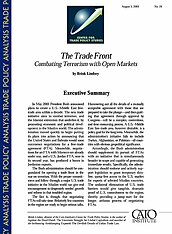The Bush administration should be congratulated for opening a trade front in the war on terrorism. With the proper commitment and follow-through, a major U.S. trade initiative in the Muslim world can give real encouragement to desperately needed growth and reform in that troubled region.
The fact is, though, that negotiating FTAs will take time. Relatively few countries in the region are ready to begin serious talks. Hammering out all the details of a mutually acceptable agreement with those that are prepared to take the plunge-and then guiding that agreement through approval by Congress-will be a complex, contentious, and time-consuming process. A U.S.-Middle East free-trade area, however desirable, is a policy goal for the long term. Meanwhile, the administration’s initiative fails to include Turkey, Afghanistan, or Pakistan-all countries with obvious geopolitical significance.
Accordingly, the Bush administration should supplement its pursuit of FTAs with an initiative that is simultaneously broader in scope and capable of generating immediate results. Specifically, the administration should endorse and actively support legislation to grant temporary duty-free, quota-free access to the U.S. market for exports of selected Muslim countries. The unilateral elimination of U.S. trade barriers would give tangible, dramatic proof of U.S. commitment to the region, thereby providing a jump-start for the longer, arduous process of negotiating FTAs.


